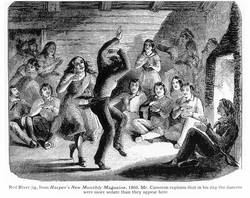Métis music was influenced both by European and Aboriginal traditions, fused into a sound uniquely their own.
The unofficial anthem of the Métis Nation is the Red River Jig. It is popularly believed that the tune grew out of gatherings of fiddlers that took place at the Forks – where the Red and Assiniboine Rivers meet, probably in the mid 1800s. Though there are variations of the tune, it is known by Métis from Alaska to James Bay and is central to the Métis identity.

Influence
The steps of the Red River Jig are influenced by the First Nation pow-wow, while at the same time contain the essentials of Scottish and Irish traditional dances. The dance consists of many steps with footwork mostly close to the ground. Some dancers have a repertoire of 20 to 30 steps and have competitions to see who can perform the fanciest combinations. The dance is often fast and intricate, the flourishes and fancy steps varying with the skill and agility of the person performing it.
Traditional Métis music is dominated by the fiddle. The instrument was first introduced to Aboriginal populations in Canada by the Scots-Irish and French-Canadian fur traders. The Métis took the instrument and imbued its sound with a vivacity totally unique to them. It was most common for Métis fiddle tunes to be passed on from person to person by ear—learned by example as opposed to reading sheet music. Every fiddle player had their own style of playing and their own version of the songs – which could change from one performance to the next.
Style
Traditional Métis music does not conform to the structure of European reels and jigs: there was no set bar structure, leaving the phrasing up to each individual fiddler. Tunings are also very flexible, and a variety of bowing techniques are used. If the song has lyrics, the key was adjusted to suit the singer. Fiddling was often accompanied by foot tapping which reflected the rhythmic beat of a drum. Since the 1940s, guitar has been used to provide a rhythmic accompaniment.
Community
Often fiddlers played together, one taking the melody while others filled in with chords or snatches of the main tune for an impromptu harmony. Music-making was often a social event in Métis circles, thus it is not surprising that where there were fiddle players there were often dancers as well.
The Red River Jig and Métis fiddle music are both products of a blend of cultures, just like the Métis themselves are a synthesis of Aboriginal and European traditions and values. Their music reflected – and continues to reflect – the life-force of a people who have faced adversity and risen above it.
. . . . .
Related Articles:
. . . . .
Author: Teyana Neufeld, 2010.
Sources:
Bolton, David. “The Red River Jig.” Manitoba Historical Society. 1 July 2009. Retrieved 11 Aug 2010. http://www.mhs.mb.ca/docs/pageant/07/redriverjig.shtml
Whidden, Lynn. “Métis Music.” Métis Legacy. Lawrence J Barkwell, Leah Dorion, Darren R Prefontaine, eds. Winnipeg: Pemmican Publications Inc, 2001.
Graphic: “273 Red River Jig c1860.” Misc. Materials Relating to the Heritage Resources of the Turtle Mountain/Souris Plains Region of Manitoba. CD-ROM. Winnipeg: Historic Resources Branch Manitoba Culture, Heritage, Tourism and Sport. 2008.
